How the inkjet printer works
The invention of inkjet printers made it possible to get full-color printing without leaving home. And so high quality that even photographic prints have a resolution inherent in ordinary photographs. And the cost of such devices allows you to purchase a future mini-laboratory in any apartment. The future user will not be prevented from knowing the structure and operation of an inkjet printer.
Content
How did the inkjet print
The discovery, which later formed the basis for inkjet printing, was discovered by the French scientist Felix Savart in 1833. The phenomenon was based on the fact that when droplets of liquid pass through a minimally narrow opening, they will have the same size and texture.
In practice, it was used only in 1951. Siemens laboratorieswhere the same consistency of droplets was detected in the voltage measuring apparatus. A decade later, the Stanford scientists presented a method according to which the same and equidistant drops fell to the surface with the help of an electric charge. Thus, voltage was formed from them, and unused particles with a charge returned back to the collector device. This is how inkjet printing was invented.
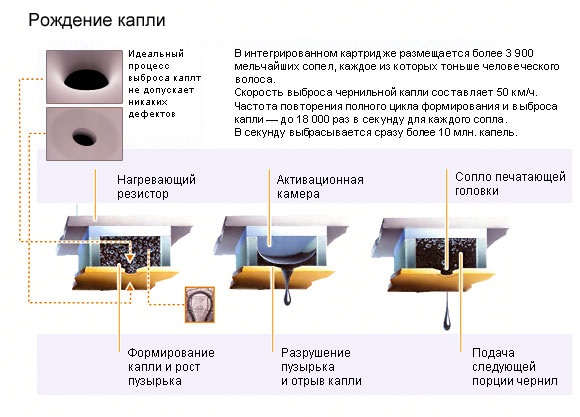
Over the past ten years, inkjet technology has impressed with its progress. If earlier it was a print of color texts, geometric shapes and simple logos, now it is realistic to print high-quality artistic images on an inkjet printer.
All modern inkjet printers - color, black and white options today simply do not produce. And being colored, they are already divided into classes:
- Color;
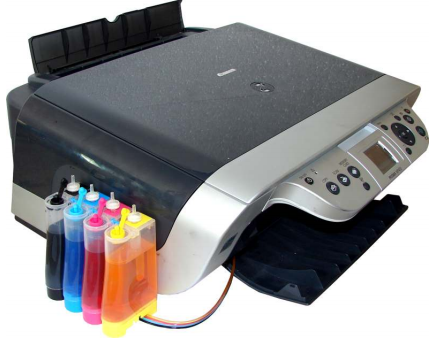
- Photo.
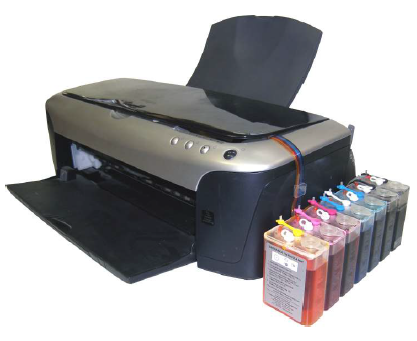
In the first case, the device operates in four-color mode, and already the photo-units use six or more colors.
What's inside
What does an inkjet printer look like? The main element is printhead (in its production laid 80% of the price of the device).It is here that the dye comes in, previously passing through the nozzles. There is no cause for concern, nothing will spill out - the holes are too small, and the paint itself will retain surface attraction. Directly under the "holes" are small cavities where the paint will flow from the tanks.
Perhaps a solution when the head comes with the cartridge, and, therefore, must be replaced with it. And there are options in which the heads are installed in the device without the possibility of replacement.
The head itself, along with ink slots, is attached to carriage. It is this part that makes a movement back and forth across a sheet of paper and ensures that paint gets on it.
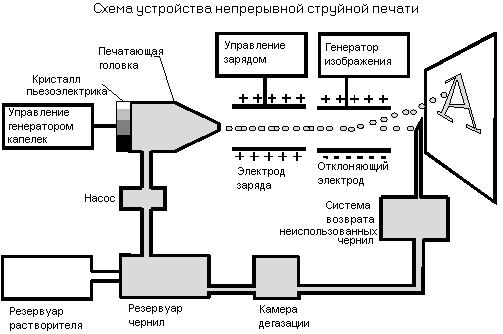
The design of the printer is such that after receiving the job sheet enters the printing compartment. Further it will move inside thanks to a special mechanism pushing it (the roller moves the motor). The paper will be additionally pressed to the sheet with special rollers. Some devices have possibility of duplex printing - in this case, printing is performed simultaneously on both sides of a sheet of paper.
How does a modern inkjet printer
Printers work with microscopic ink droplets with several colors.The principle of operation of an inkjet printer is similar to the matrix units, but here instead of needles, nozzles are used, through which paint comes in a drop form on a sheet of paper. The size of each drop is a few tenths of a micron in diameter (which is substantially thinner than even an ordinary human hair). Only under a microscope can you see a lot of mini-points that make up the image.
The droplets enter the paper by extrusion. And here different manufacturers use different printing technologies.
- Thermal method Got birth in the 70s at Canon. Its essence lies in the microscopic element, which is located in the nozzles - it can instantly heat up to huge temperature regimes. This contributes to the formation of gas bubbles ejecting paint. Today, Canon and HP are working on this method.

- Piezoelectric option based on the fact that a piezocrystal is located above the nozzle. When an electric current is applied to it, it begins to bend and pulls the diaphragms behind it. Increased pressure is created, which pushes a drop onto the material.This method formed the basis for the creation of devices from Epson.
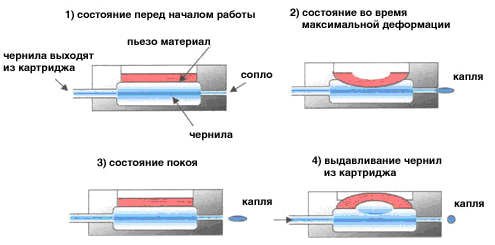
Each of these technologies has its pros and cons.
- Thermotechnology is associated with high temperatures. This causes the formation of a fouling layer and contributes to the failure of the print head.
- The piezoelectric element is the cheapest option and allows you to achieve high speeds in operation.
Any inkjet printers have their drawbacks. The most important of them are the slow process of work and the high cost of printing. Another point is the use of photo paper with a special coating for printing photos. In addition, the cartridge has a small size, and therefore a disadvantageous resource.
The last aspect indicates a significant expensive device maintenance. Thus, with a constant change of cartridges in strujniki, this will significantly affect the budget. However, the output was found - printing units with CISS.
Difference between cartridges and CISS
One of the main elements of the inkjet is a cartridge device, which has in its composition a special plate with printing elements (a head with a chip) and an ink-containing container.
Cartridges are divided into two types:
- Separatein which only monochromatic inks are used (for the older generation of inkjets).

HP CD971AE 920 Inkjet Printer Cartridge Black
- Combined variants in which there are three compartments containing, for example, magenta, yellow and cyan ink.
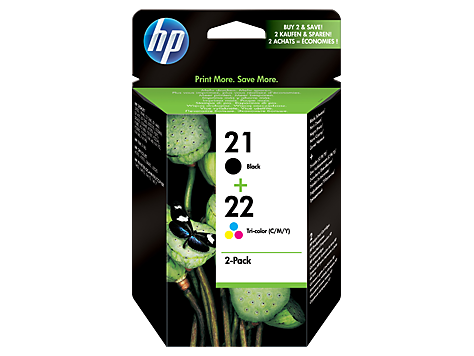
HP 21/22 Combination Inkjet Print Cartridge Pack
The latter option is more modern, but it is used for small volumes of work. Another major drawback is that if one color dries up, then you have to throw out the whole part (even if there are enough other colors).
To prevent this, you can use the nozzle cleaning system.
But SPN, in its essence, provides ink supply by gravity". A system with such capabilities consists of the following parts:
- paint compartments;
- paint tubes;
- microchips that are automatically reset.
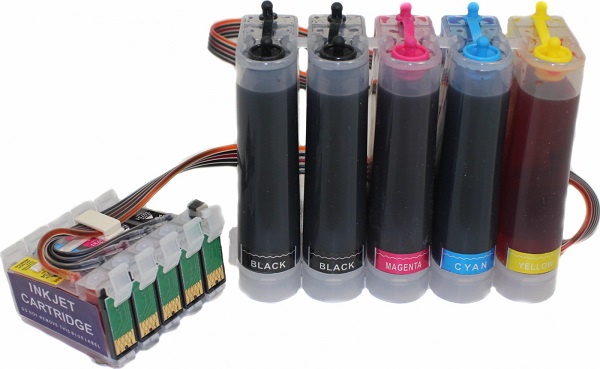
How does ciss work? The membranes of the piezoelectric elements of the printhead are involved here - during operation, a discharge begins in the cartridge part of the CISP. Then begins the ink flow. The system is completely sealed and allows you to maintain a constant level of paint.
The advantages of the CISS are that such an attachment reduces the cost of buying cartridges. This especially helps when working with large volumes of printing. At cost, it is much cheaper than color laser devices. CISS is very easy to install and use - even a novice user can handle it. But you need to know about the small difference between the cartridge and capsule systems.
- AT cartridge system in place of the original models of cartridges there are similar constants that have an autochip, which gives signals as they empty.
- And in capsule model Capsules are placed on the input “needles” of the print head itself. This option is easy to maintain - the capsules have transparent walls and the user can control the level of paint at any time.
What ink is needed for an inkjet printer?
The paint used in devices can be divided into specific groups. We give the characteristics of each of them.
- Water solublewhich can easily be dissolved in water. On paper, they are perfectly absorbed into the fibers and provide an even continuous layer. This ensures excellent color reproduction. The most common is solvent type ink.
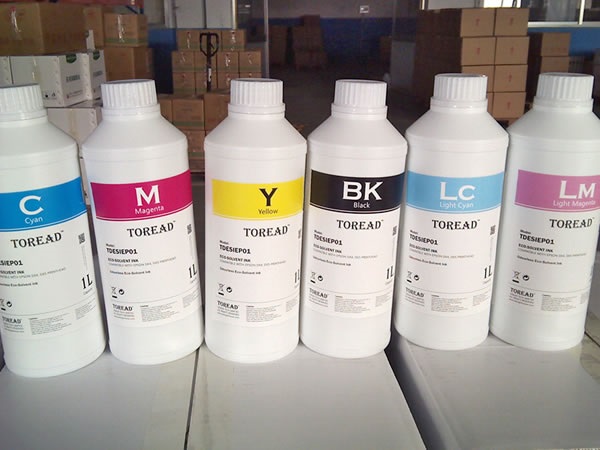
Original eco solvent ink for Phaeton printers
- Pigment Ink is usually used in interior printing and in obtaining photographs. They are based on solid particles - these images are not washed away with water, they remain saturated and bright for a large amount of time. But there are also disadvantages - such inks are much more expensive and dry quickly in the nodes of printers. In addition, when printing with such materials, it is not possible to achieve high resolution (this is compensated by using more colors).
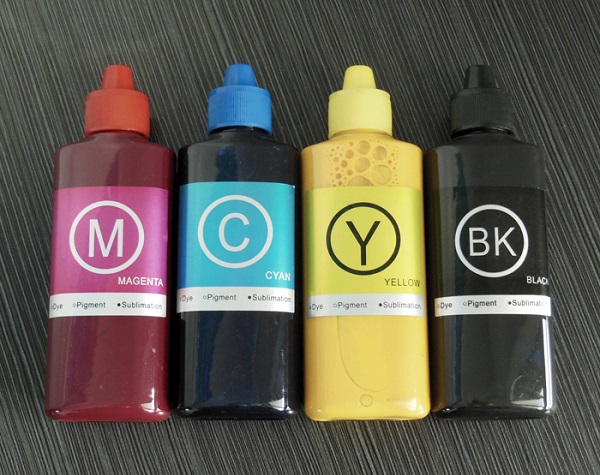
Pigment Ink for HP Printer
- Sublimation paint has a similar structure with pigment (the scope and properties are different). Such inks are used to transfer images to synthetic fibers. A printer with sublimation printing and special paper (thermotransfer type) are used for this. It is best to install a CISS. You need to know that transfer to the fabric is carried out at very high temperatures. In everyday life, you can use an ordinary iron, but to obtain a better result, a heat press is needed - in it the sublimation dye will enter into a gaseous state and permeate the surface.
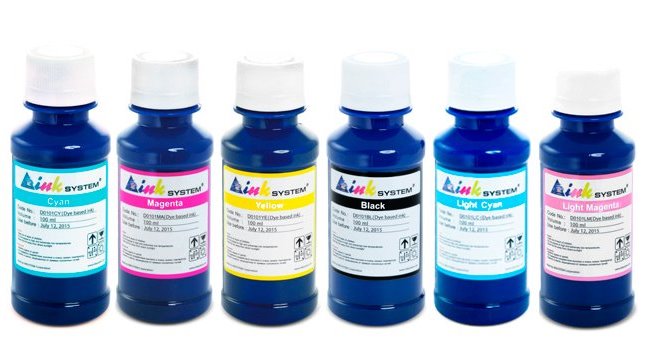
INKSYSTEM Dye Sublimation Ink Kit
Inkjet printer is an interesting and great opportunity to get high-quality color and photo tools. Such an acquisition is especially popular for artists and photographers. However, before buying is to ask yourself the question: how necessary such a device? And, of course, you should know its internal structure and possibilities of work - this will allow you to choose the most optimal option for yourself.

/rating_off.png)











